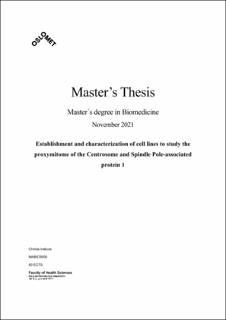| dc.contributor.advisor | Stokke, Trond | |
| dc.contributor.advisor | Patzke, Sebastian | |
| dc.contributor.author | Irakoze, Christa | |
| dc.date.accessioned | 2022-02-17T08:47:20Z | |
| dc.date.available | 2022-02-17T08:47:20Z | |
| dc.date.issued | 2021 | |
| dc.identifier.uri | https://hdl.handle.net/11250/2979555 | |
| dc.description.abstract | The predominantly expressed isoform of CSPP1, CSPP-L, is a centrosomal and Centriolar satellite protein with functions in microtubule organization in cell division and cilia formation. CSPP-L dose and microtubule organizing activity need to be tightly regulated. Its over-expression manifests in multipolar spindle assembly and cell division failure, which is a hallmark of cancer. Its depletion or functional loss manifests in defective cilia assembly and signaling, and is also an underlying cause of a human ciliopathy. The mechanism controlling CSPP-L’s activity and localization are not understood. Aim: The aim of this project was to generate and characterize cell lines expressing a miniTurboID-CSPP-L fusion protein. The miniTurboID-tag encodes for a promiscuous biotin-ligase, which can be exploited to label proteins that are proximal to CSPP-L in a living cell. Material and methods: Molecular genetics and cell biological techniques were used to construct and produce lentiviral particles to stably introduce a miniTurboID-CSPP-L expressing cassette into hTERT-RPE1 cells. Immunofluorescence microscopy and Western blot were used to characterize these cell lines. The localization pattern of miniTurboID-CSPP-L and biotinylation-activity were studied by immunofluorescence microscopy, and biotinylated proteins were tried isolated using streptavidin-agarose. Results: Cell lines expressing miniTurboID-CSPP-L protein were constructed. The fusion protein localizes to and rapidly biotinylates proteins at Centriolar satellites, the centrosome, and mitotic spindle. Unexpectedly, in initial analyses the fusion protein was not detected at primary cilia. This should be studied further. Fluorescens microscopy confirmed biotinylation of proteins within 5-10 minutes after addition of biotin. Preparative extraction of biotinylated proteins required further optimization. Conclusion: We successfully generated hTERT-RPE1 cells expressing CSPP-L that can be used to determine its proxymitome in living cells at high temporal resolution. The N-terminally tagged fusion protein localizes to centrosomes and Centriolar satellites. Further work is warranted to investigate the potential perturbance of CSPP-L’s ciliary function/localization by fusion to the miniTurboID-tag. | en_US |
| dc.description.abstract | Bakgrunn: CSPP-L er et centrosomalt og Centriolært satellitt protein som lokaliserer til den mitotiske spindelen under mitosen og til det primære cilium i serum sultede celler. Overutrykk av CSPP-L er assosiert med kreft, og fører til avvik under celledelig og dannelse av multipolare spindeler. Når CSPP-L ikke uttrykkes eller er mutert fører dette til feil i dannelse og funksjon av cilia, dette er igjen en underliggende årsak for ciliopati. Mål: Målet med dette prosjektet var å etablere cellelinjer som uttrykker miniTurboID-CSPPL fusjonsproteinet. miniTurboID-tagen koder for en biotin ligase som kan brukes til å merke proteiner som er i nærheten av fusjonsproteinet i levende celler. Material og metode: Immunofluorescens mikroskopi og Western blot ble benyttet til å studere lokalisering av miniTurboID-CSPP-L. Biotinylerte proteiner ble også obsevert ved Immunofluorescens mikroskopi, deretter forsøkt isolert og ekstrahert med streptavidinagarose kuler. Resultater: miniTurboID-CSPP-L proteinet lokaliserte som forventet til centrosomet og Centriolære satelliter, men ble ikke detektert ved det primær ciliumet. Det ble også undersøkt om miniTurboID-CSPP-L biotinylerte proteiner. Resultatetene viste biotinylerte proteiner etter 5-10 min. Konklusjon: Det ble laget celler som uttrykker miniTurboID-CSPP-L og som er i stand til å biotinylere proteiner i nærhet. Lokalisering av miniTurboID-CSPP-L til centrosomene og Centriolære satelliter ble validert, men lokalisering til det primær ciliumet må studeres videre. | en_US |
| dc.language.iso | eng | en_US |
| dc.publisher | OsloMet - Storbyuniversitetet | en_US |
| dc.subject | 3-Dimentional Structured Illumination Microscopy | en_US |
| dc.subject | Centrosome | en_US |
| dc.subject | Microtubules | en_US |
| dc.subject | Proximity-dependent biotin identification | en_US |
| dc.subject | Protein structure | en_US |
| dc.title | Establishment and characterization of cell lines to study the proxymitome of the Centrosome and Spindle Pole-associated protein 1 | en_US |
| dc.type | Master thesis | en_US |
| dc.description.version | publishedVersion | en_US |
| dc.source.pagenumber | 67 | en_US |
| dc.subject.nsi | VDP::Medisinske Fag: 700::Basale medisinske, odontologiske og veterinærmedisinske fag: 710::Medisinsk molekylærbiologi: 711 | en_US |
